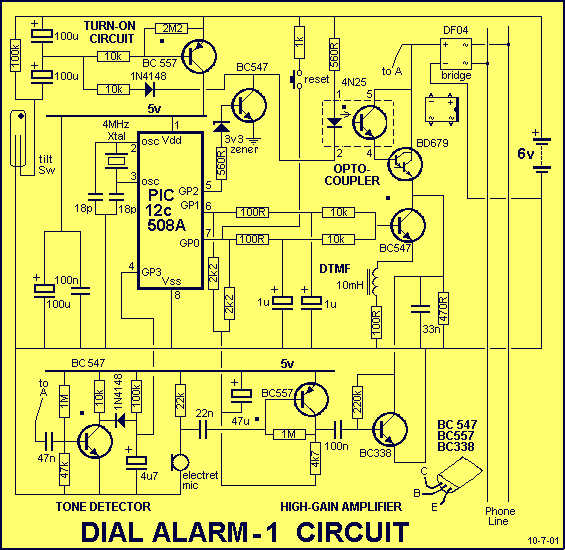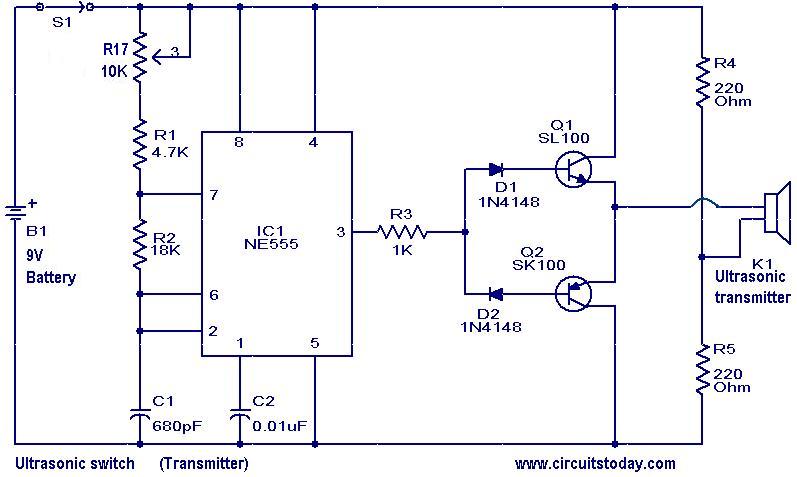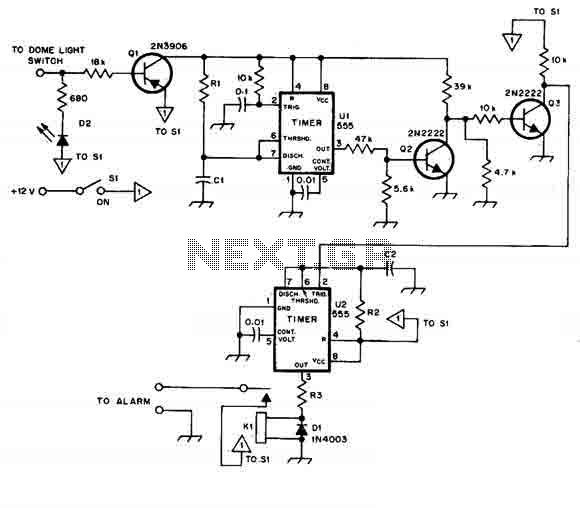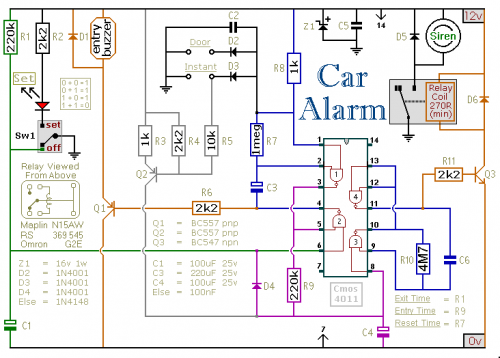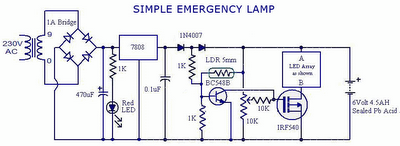
How To Build A Simple Keypad Switch With A Tamper Alarm
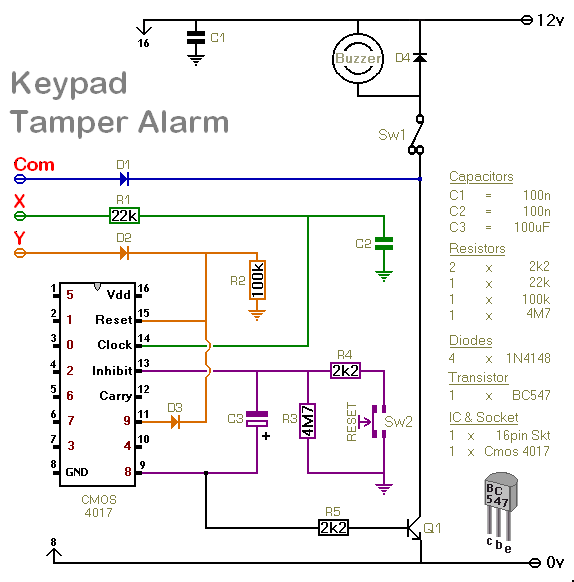
This circuit is designed for use with a Universal Keypad Operated Switch. A few genuine mistakes made during code entry will not activate the device. However, repeated attempts to input the correct code through trial and error will cause the keypad to lock and the buzzer to sound. By connecting the coil of a suitable relay to the buzzer output, a siren can be activated instead. The circuit utilizes a CMOS 4017 decade counter, which counts the number of times a "wrong" key is pressed. When the count reaches eight, it activates the alarm and locks the keypad. The alarm will continue to sound, and the keypad will remain locked for a duration determined by the values of capacitor C3 and resistor R3. With the specified values, this duration is approximately five minutes. After this period, the keypad becomes active again, and the alarm is silenced. Two control switches are provided: the first switch (Sw1) simply silences the alarm while leaving the keypad locked, allowing for alarm deactivation without compromising keypad security. The second switch (Sw2) shortens the charging time for C3, removing the keypad lock and silencing the alarm. Any small normally-open switch can be used for Sw2. A magnetic reed switch can be concealed within the keypad housing and activated with a magnet to reset the alarm. Three connections are required between the Tamper-Alarm and the Keypad Circuit: connect "Com" on the Tamper-Alarm Circuit to "Com" on the Keypad Circuit, "X" on the Tamper-Alarm Circuit to Pin 1 of the 4081, and "Y" on the Tamper-Alarm Circuit to the junction of the relay coil and the collector of Q6. The count increments by one each time a "wrong" key is pressed. A "wrong" key is defined as any key that pulls Pin 1 of the 4081 low. The key "E" pulls Pin 1 low, thus it is considered a wrong key. Pressing "E" to energize the relay will always advance the count to one, leaving seven additional wrong-key inputs before the Tamper-Alarm activates. It is important to note that keys "A" and "B" do not pull Pin 1 low, so pressing them does not advance the count.
The circuit operates by integrating several components to ensure effective tamper protection and user feedback through auditory signals. The CMOS 4017 decade counter is pivotal in counting the number of incorrect key presses, providing a straightforward method for determining when to activate the alarm system. The alarm system is designed to deter unauthorized access while allowing legitimate users to reset the system without complete deactivation.
The use of a relay connected to the buzzer output enables the option to integrate a more powerful alarm system, such as a siren, enhancing the deterrent effect. The choice of C3 and R3 values is critical, as these components dictate the time delay for keypad reactivation post-lockout, allowing for a balance between security and user convenience.
The inclusion of control switches Sw1 and Sw2 provides flexibility in managing the alarm system. Sw1's function to silence the alarm without unlocking the keypad allows users to manage false alarms effectively, while Sw2's ability to reset the system quickly is crucial in emergency situations. The design also accommodates the use of a magnetic reed switch for stealthy operation, which can be particularly useful in applications requiring discreet security measures.
Connections between the Tamper-Alarm and Keypad Circuit are straightforward, ensuring ease of integration into existing systems. The logic behind the counting mechanism is robust, allowing for a clear distinction between valid and invalid key presses, thereby enhancing the overall security of the system. This circuit design effectively combines functionality and security, making it suitable for various applications requiring keypad access control.This circuit is designed to be used with the Universal Keypad Operated Switch. A few genuine mistakes - made during code entry - will not activate the device. But repeated attempts to find the correct code by trial and error - will cause the keypad to lock-up - and the Buzzer to sound. Connect the coil of a suitable relay to the Buzzer output - a nd you can sound a Siren instead. The circuit uses a Cmos 4017 decade counter. It counts the number of times a "Wrong" key is pressed. When the count reaches eight - it sounds the alarm and locks the keypad. The alarm will continue to sound - and the keypad will remain locked - for a period of time set by the values of C3 and R3. With the values shown - this takes about five minutes. Then the keypad becomes active once more - and the alarm is silenced. Two different control switches are provided. The first - Sw1 - simply stops the noise. Removing the lock from the keypad is left to the timer circuit. Sw1 gives you the option to silence the alarm - and still retain the keypad protection. Sw2 shortens the time it takes for C3 to charge. It both removes the lock from the keypad - and stops the noise. Any small normally-open switch will do. If you use a magnetic reed-switch - you can hide the switch within the keypad housing - and use a magnet to reset the alarm.
There are three connections to be made between the Tamper-Alarm and the Keypad Circuit. Connect "Com" on the Tamper-Alarm Circuit to "Com" on the Keypad Circuit. Connect "X" on the Tamper-Alarm Circuit to Pin 1 of the 4081. And connect "Y" on the Tamper-Alarm Circuit to the junction of the relay coil and the collector of Q6. The count advances by one every time a "Wrong" key is pressed. A wrong key is any key that takes pin 1 of the 4081 low. Since "E" takes pin 1 low - "E" is a wrong key. Therefore - when you press "E" to energize the relay - the count will always advance to one. That leaves seven more wrong-key inputs before the Tamper-Alarm will activate. Note that "A" and "B" never take pin 1 low - so pressing them does not advance the count. 🔗 External reference
The circuit operates by integrating several components to ensure effective tamper protection and user feedback through auditory signals. The CMOS 4017 decade counter is pivotal in counting the number of incorrect key presses, providing a straightforward method for determining when to activate the alarm system. The alarm system is designed to deter unauthorized access while allowing legitimate users to reset the system without complete deactivation.
The use of a relay connected to the buzzer output enables the option to integrate a more powerful alarm system, such as a siren, enhancing the deterrent effect. The choice of C3 and R3 values is critical, as these components dictate the time delay for keypad reactivation post-lockout, allowing for a balance between security and user convenience.
The inclusion of control switches Sw1 and Sw2 provides flexibility in managing the alarm system. Sw1's function to silence the alarm without unlocking the keypad allows users to manage false alarms effectively, while Sw2's ability to reset the system quickly is crucial in emergency situations. The design also accommodates the use of a magnetic reed switch for stealthy operation, which can be particularly useful in applications requiring discreet security measures.
Connections between the Tamper-Alarm and Keypad Circuit are straightforward, ensuring ease of integration into existing systems. The logic behind the counting mechanism is robust, allowing for a clear distinction between valid and invalid key presses, thereby enhancing the overall security of the system. This circuit design effectively combines functionality and security, making it suitable for various applications requiring keypad access control.This circuit is designed to be used with the Universal Keypad Operated Switch. A few genuine mistakes - made during code entry - will not activate the device. But repeated attempts to find the correct code by trial and error - will cause the keypad to lock-up - and the Buzzer to sound. Connect the coil of a suitable relay to the Buzzer output - a nd you can sound a Siren instead. The circuit uses a Cmos 4017 decade counter. It counts the number of times a "Wrong" key is pressed. When the count reaches eight - it sounds the alarm and locks the keypad. The alarm will continue to sound - and the keypad will remain locked - for a period of time set by the values of C3 and R3. With the values shown - this takes about five minutes. Then the keypad becomes active once more - and the alarm is silenced. Two different control switches are provided. The first - Sw1 - simply stops the noise. Removing the lock from the keypad is left to the timer circuit. Sw1 gives you the option to silence the alarm - and still retain the keypad protection. Sw2 shortens the time it takes for C3 to charge. It both removes the lock from the keypad - and stops the noise. Any small normally-open switch will do. If you use a magnetic reed-switch - you can hide the switch within the keypad housing - and use a magnet to reset the alarm.
There are three connections to be made between the Tamper-Alarm and the Keypad Circuit. Connect "Com" on the Tamper-Alarm Circuit to "Com" on the Keypad Circuit. Connect "X" on the Tamper-Alarm Circuit to Pin 1 of the 4081. And connect "Y" on the Tamper-Alarm Circuit to the junction of the relay coil and the collector of Q6. The count advances by one every time a "Wrong" key is pressed. A wrong key is any key that takes pin 1 of the 4081 low. Since "E" takes pin 1 low - "E" is a wrong key. Therefore - when you press "E" to energize the relay - the count will always advance to one. That leaves seven more wrong-key inputs before the Tamper-Alarm will activate. Note that "A" and "B" never take pin 1 low - so pressing them does not advance the count. 🔗 External reference
